Highly Efficient Adsorption Characteristics and Mechanism of Nutshell Biochars for Aromatic Organophosphorus Insecticides
Abstract
:1. Introduction
2. Materials and Methods
2.1. Biochars and Reagents
2.2. Adsorption Characteristics of Biochar on Profenofos
2.3. Adsorption Kinetics Analysis
2.4. Adsorption Isotherm Analysis
2.5. Adsorption Thermodynamics Analysis
2.6. Characterization of Biochars
2.7. Adsorption of OP Structural Analogs
3. Results and Discussion
3.1. Nutshell Biochar Showed Superior Adsorption Performance for Profenofos
3.2. Nutshell Biochars Showed Extremely Fast Adsorption Rate for Profenofos
3.3. Nutshell Biochars Showed a Stabile Adsorption Capacity in Different Environments
3.3.1. Effect of Initial Concentration of Profenofos
3.3.2. Effect of Temperature
3.3.3. Effect of pH
3.3.4. Desorption and Reuse
3.4. Adsorption of Profenofos in Biochars by π-π and Hydrophobic Interactions
3.4.1. FTIR Analysis of Biochars
3.4.2. Adsorption of Similarly Structured OPs onto Coconut Shell Biochar
3.5. Adsorption Mechanism of Nutshell Biochars
4. Conclusions
Supplementary Materials
Author Contributions
Funding
Data Availability Statement
Acknowledgments
Conflicts of Interest
References
- Alouw, J.; Wulandari, S. Present Status and Outlook of Coconut Development in Indonesia; IOP Publishing: Bogor, Indonesia, 2020; p. 012035. [Google Scholar]
- Massantini, R.; Frangipane, M.T. Progress in Almond Quality and Sensory Assessment: An Overview. Agriculture 2022, 12, 710. [Google Scholar] [CrossRef]
- Orooji, Y.; Han, N.; Nezafat, Z.; Shafiei, N.; Shen, Z.; Nasrollahzadeh, M.; Karimi-Maleh, H.; Luque, R.; Bokhari, A.; Klemeš, J.J. Valorisation of nuts biowaste: Prospects in sustainable bio (nano) catalysts and environmental applications. J. Clean. Prod. 2022, 347, 131220. [Google Scholar]
- Yuliusman Sipangkar, S.P.; Fatkhurrahman, M.; Farouq, F.A.; Putri, S.A. Utilization of Coconut Husk Waste in the Preparation of Activated Carbon by Using Chemical Activators of KOH and NaOH; AIP Publishing LLC: Bali, Indonesia, 2020; p. 060026. [Google Scholar]
- Wang, J.; Wang, S. Preparation, modification and environmental application of biochar: A review. J. Clean. Prod. 2019, 227, 1002–1022. [Google Scholar] [CrossRef]
- Chen, H.; Tang, L.; Hu, Y.; Geng, Y.; Meng, L.; Li, W.; Wang, Z.; Li, Z.; Huo, Z. Investigating the pathways of enhanced Pb immobilization by chlorine-loaded biochar. J. Clean. Prod. 2022, 344, 131097. [Google Scholar] [CrossRef]
- Lai, W.; Wu, Y.; Zhang, C.; Dilinuer, Y.; Pasang, L.; Lu, Y.; Wang, Y.; Chen, H.; Li, Z. Combination of biochar and phosphorus solubilizing bacteria to improve the stable form of toxic metal minerals and microbial abundance in Lead/Cadmium-contaminated soil. Agronomy 2022, 12, 1003. [Google Scholar] [CrossRef]
- Praveen, S.; Jegan, J.; Bhagavathi Pushpa, T.; Gokulan, R.; Bulgariu, L. Biochar for removal of dyes in contaminated water: An overview. Biochar 2022, 4, 10. [Google Scholar] [CrossRef]
- Gautam, R.K.; Goswami, M.; Mishra, R.K.; Chaturvedi, P.; Awashthi, M.K.; Singh, R.S.; Giri, B.S.; Pandey, A. Biochar for remediation of agrochemicals and synthetic organic dyes from environmental samples: A review. Chemosphere 2021, 272, 129917. [Google Scholar] [CrossRef]
- Chen, H.; Tang, L.; Wang, Z.; Su, M.; Tian, D.; Zhang, L.; Li, Z. Evaluating the protection of bacteria from extreme Cd (II) stress by P-enriched biochar. Environ. Pollut. 2020, 263, 114483. [Google Scholar] [CrossRef] [PubMed]
- Chen, H.; Zhang, J.; Tang, L.; Su, M.; Tian, D.; Zhang, L.; Li, Z.; Hu, S. Enhanced Pb immobilization via the combination of biochar and phosphate solubilizing bacteria. Environ. Int. 2019, 127, 395–401. [Google Scholar] [CrossRef]
- Tomczyk, A.; Sokołowska, Z.; Boguta, P. Biochar physicochemical properties: Pyrolysis temperature and feedstock kind effects. Rev. Environ. Sci. Bio/Technol. 2020, 19, 191–215. [Google Scholar] [CrossRef]
- Zhang, X.; Zhang, P.; Yuan, X.; Li, Y.; Han, L. Effect of pyrolysis temperature and correlation analysis on the yield and physicochemical properties of crop residue biochar. Bioresour. Technol. 2020, 296, 122318. [Google Scholar] [CrossRef]
- Tsai, C.-Y.; Lin, P.-Y.; Hsieh, S.-L.; Kirankumar, R.; Patel, A.K.; Singhania, R.-R.; Dong, C.-D.; Chen, C.-W.; Hsieh, S. Engineered mesoporous biochar derived from rice husk for efficient removal of malachite green from wastewaters. Bioresour. Technol. 2022, 347, 126749. [Google Scholar] [CrossRef]
- Cheng, X.; Wang, B. Influence of organic composition of biomass waste on biochar yield, calorific value, and specific surface area. J. Renew. Sustain. Energy 2018, 10, 013109. [Google Scholar] [CrossRef]
- Queirós, C.S.; Cardoso, S.; Lourenço, A.; Ferreira, J.; Miranda, I.; Lourenço MJ, V.; Pereira, H. Characterization of walnut, almond, and pine nut shells regarding chemical composition and extract composition. Biomass Convers. Biorefinery 2020, 10, 175–188. [Google Scholar] [CrossRef]
- Xu, H.; Han, Y.; Wang, G.; Deng, P.; Feng, L. Walnut shell biochar based sorptive remediation of estrogens polluted simulated wastewater: Characterization, adsorption mechanism and degradation by persistent free radicals. Environ. Technol. Innov. 2022, 28, 102870. [Google Scholar] [CrossRef]
- Zazycki, M.A.; Godinho, M.; Perondi, D.; Foletto, E.L.; Collazzo, G.C.; Dotto, G.L. New biochar from pecan nutshells as an alternative adsorbent for removing reactive red 141 from aqueous solutions. J. Clean. Prod. 2018, 171, 57–65. [Google Scholar] [CrossRef]
- Fu, H.; Tan, P.; Wang, R.; Li, S.; Liu, H.; Yang, Y.; Wu, Z. Advances in organophosphorus pesticides pollution: Current status and challenges in ecotoxicological, sustainable agriculture, and degradation strategies. J. Hazard. Mater. 2022, 424, 127494. [Google Scholar]
- Zhang, Y.; Qin, P.; Lu, S.; Liu, X.; Zhai, J.; Xu, J.; Wang, Y.; Zhang, G.; Liu, X.; Wan, Z. Occurrence and risk evaluation of organophosphorus pesticides in typical water bodies of Beijing, China. Environ. Sci. Pollut. Res. 2021, 28, 1454–1463. [Google Scholar] [CrossRef]
- Li, Z.; Sun, J.; Zhu, L. Organophosphorus pesticides in greenhouse and open-field soils across China: Distribution characteristic, polluted pathway and health risk. Sci. Total Environ. 2021, 765, 142757. [Google Scholar] [CrossRef] [PubMed]
- Fang, L.; Shi, Q.; Xu, L.; Shi, T.; Wu, X.; Li, Q.X.; Hua, R. Enantioselective Uptake Determines Degradation Selectivity of Chiral Profenofos in Cupriavidus nantongensis X1T. J. Agric. Food Chem. 2020, 68, 6493–6501. [Google Scholar] [CrossRef] [PubMed]
- Xu, M.; Yang, F. Integrated gender-related effects of profenofos and paclobutrazol on neurotransmitters in mouse. Ecotoxicol. Environ. Saf. 2020, 190, 110085. [Google Scholar] [CrossRef] [PubMed]
- Kushwaha, M.; Verma, S.; Chatterjee, S. Profenofos, an Acetylcholinesterase-Inhibiting Organophosphorus Pesticide: A Short Review of Its Usage, Toxicity, and Biodegradation. J. Environ. Qual. 2016, 45, 1478–1489. [Google Scholar] [CrossRef]
- Mahboob, S.; Niazi, F.; Alghanim, K.; Sultana, S.; Al-Misned, F.; Ahmed, Z. Health risks associated with pesticide residues in water, sediments and the muscle tissues of Catla catla at Head Balloki on the River Ravi. Environ. Monit. Assess. 2015, 187, 81. [Google Scholar] [CrossRef]
- Sultana, Z.; Khan, M.; Mostakim, G.M.; Moniruzzaman, M.; Rahman, M.; Shahjahan, M.; Islam, M.S. Studying the effects of profenofos, an endocrine disruptor, on organogenesis of zebrafish. Environ. Sci. Pollut. Res. 2021, 28, 20659–20667. [Google Scholar] [CrossRef]
- Khedr, T.; Hammad, A.A.; Elmarsafy, A.M.; Halawa, E.; Soliman, M. Degradation of some organophosphorus pesticides in aqueous solution by gamma irradiation. J. Hazard. Mater. 2019, 373, 23–28. [Google Scholar] [CrossRef]
- Mansouriieh, N.; Sohrabi, M.; Khosravi, M. Adsorption kinetics and thermodynamics of organophosphorus profenofos pesticide onto Fe/Ni bimetallic nanoparticles. Int. J. Environ. Sci. Technol. 2016, 13, 1393–1404. [Google Scholar] [CrossRef]
- Dai, Y.; Zhang, N.; Xing, C.; Cui, Q.; Sun, Q. The adsorption, regeneration and engineering applications of biochar for removal organic pollutants: A review. Chemosphere 2019, 223, 12–27. [Google Scholar] [CrossRef]
- Baharum, N.A.; Nasir, H.M.; Ishak, M.Y.; Isa, N.M.; Hassan, M.A.; Aris, A.Z. Highly efficient removal of diazinon pesticide from aqueous solutions by using coconut shell-modified biochar. Arab. J. Chem. 2020, 13, 6106–6121. [Google Scholar] [CrossRef]
- Uchimiya, M.; Wartelle, L.H.; Boddu, V.M. Sorption of triazine and organophosphorus pesticides on soil and biochar. J. Agric. Food Chem. 2012, 60, 2989–2997. [Google Scholar] [CrossRef] [PubMed]
- Zheng, H.; Zhang, Q.; Liu, G.; Luo, X.; Li, F.; Zhang, Y.; Wang, Z. Characteristics and mechanisms of chlorpyrifos and chlorpyrifos-methyl adsorption onto biochars: Influence of deashing and low molecular weight organic acid (LMWOA) aging and co-existence. Sci. Total Environ. 2019, 657, 953–962. [Google Scholar] [CrossRef] [PubMed]
- Shi, T.; Fang, L.; Qin, H.; Wu, X.; Li, Q.X.; Hua, R. Minute-speed biodegradation of Organophosphorus insecticides by Cupriavidus nantongensis X1T. J. Agric. Food Chem. 2019, 67, 13558–13567. [Google Scholar] [CrossRef]
- Jung, C.; Park, J.; Lim, K.H.; Park, S.; Heo, J.; Her, N.; Oh, J.; Yun, S.; Yoon, Y. Adsorption of selected endocrine disrupting compounds and pharmaceuticals on activated biochars. J. Hazard. Mater. 2013, 263, 702–710. [Google Scholar] [CrossRef]
- Somsesta, N.; Sricharoenchaikul, V.; Aht-Ong, D. Adsorption removal of methylene blue onto activated carbon/cellulose biocomposite films: Equilibrium and kinetic studies. Mater. Chem. Phys. 2020, 240, 122221. [Google Scholar] [CrossRef]
- Wang, T.; Liu, S.; Mao, W.; Bai, Y.; Chiang, K.; Shah, K.; Paz-Ferreiro, J. Novel Bi2WO6 loaded N-biochar composites with enhanced photocatalytic degradation of rhodamine B and Cr (VI). J. Hazard. Mater. 2020, 389, 121827. [Google Scholar] [CrossRef]
- Huong, P.T.; Jitae, K.; Al Tahtamouni, T.; Tri, N.L.M.; Kim, H.-H.; Cho, K.H.; Lee, C. Novel activation of peroxymonosulfate by biochar derived from rice husk toward oxidation of organic contaminants in wastewater. J. Water Process Eng. 2020, 33, 101037. [Google Scholar] [CrossRef]
- Huang, Q.; Song, S.; Chen, Z.; Hu, B.; Chen, J.; Wang, X. Biochar-based materials and their applications in removal of organic contaminants from wastewater: State-of-the-art review. Biochar 2019, 1, 45–73. [Google Scholar] [CrossRef]
- Tong, Y.; Mcnamara, P.J.; Mayer, B.K. Adsorption of organic micropollutants onto biochar: A review of relevant kinetics, mechanisms and equilibrium. Environ. Sci. Water Res. Technol. 2019, 5, 821–838. [Google Scholar] [CrossRef]
- Wang, P.; Liu, X.; Yu, B.; Wu, X.; Xu, J.; Dong, F.; Zheng, Y. Characterization of peanut-shell biochar and the mechanisms underlying its sorption for atrazine and nicosulfuron in aqueous solution. Sci. Total Environ. 2020, 702, 134767. [Google Scholar] [CrossRef] [PubMed]
- Choudhary, M.; Kumar, R.; Neogi, S. Activated biochar derived from Opuntia ficus-indica for the efficient adsorption of malachite green dye, Cu2+ and Ni2+ from water. J. Hazard. Mater. 2020, 392, 122441. [Google Scholar] [CrossRef]
- De Souza, M.J.B.; Silva, T.H.A.; Ribeiro, T.R.S.; Da Silva, A.O.S.; Pedrosa, A.M.G. Thermal and catalytic pyrolysis of polyvinyl chloride using micro/mesoporous ZSM-35/MCM-41 catalysts. J. Therm. Anal. Calorim. 2020, 140, 167–175. [Google Scholar] [CrossRef]
- Hadi, S.; Taheri, E.; Amin, M.M.; Fatehizadeh, A.; Aminabhavi, T.M. Adsorption of 4-chlorophenol by magnetized activated carbon from pomegranate husk using dual stage chemical activation. Chemosphere 2021, 270, 128623. [Google Scholar] [CrossRef] [PubMed]
- Liu, W.; Ren, D.; Wu, J.; Wang, Z.; Zhang, S.; Zhang, X.; Gong, X. Adsorption behavior of 2, 4-DCP by rice straw biochar modified with CTAB. Environ. Technol. 2021, 42, 3797–3806. [Google Scholar] [CrossRef] [PubMed]
- Huang, W.; Zhang, M.; Wang, Y.; Chen, J.; Zhang, J. Biochars prepared from rabbit manure for the adsorption of rhodamine B and Congo red: Characterisation, kinetics, isotherms and thermodynamic studies. Water Sci. Technol. 2020, 81, 436–444. [Google Scholar] [CrossRef] [PubMed]
- Miao, Q.; Bi, E.; Li, B. Roles of polar groups and aromatic structures of biochar in 1-methyl-3-octylimidazolium chloride ionic liquid adsorption: pH effect and thermodynamics study. Environ. Sci. Pollut. Res. 2017, 24, 22265–22274. [Google Scholar] [CrossRef]
- Tran, H.N.; Tomul, F.; Ha, N.T.H.; Nguyen, D.T.; Lima, E.C.; Le, G.T.; Chang, C.-T.; Masindi, V.; Woo, S.H. Innovative spherical biochar for pharmaceutical removal from water: Insight into adsorption mechanism. J. Hazard. Mater. 2020, 394, 122255. [Google Scholar] [CrossRef] [PubMed]
- Dewage, N.B.; Liyanage, A.S.; Pittman, C.U., Jr.; Mohan, D.; Mlsna, T. Fast nitrate and fluoride adsorption and magnetic separation from water on α-Fe2O3 and Fe3O4 dispersed on Douglas fir biochar. Bioresour. Technol. 2018, 263, 165–258. [Google Scholar] [CrossRef] [PubMed]
- Liu, G.; Li, L.; Huang, X.; Zheng, S.; Xu, X.; Liu, Z.; Zhang, Y.; Wang, J.; Lin, H.; Xu, D. Adsorption and removal of organophosphorus pesticides from environmental water and soil samples by using magnetic multi-walled carbon nanotubes@ organic framework ZIF-8. J. Mater. Sci. 2018, 53, 10772–10783. [Google Scholar] [CrossRef]
- Wei, M.; Marrakchi, F.; Yuan, C.; Cheng, X.; Jiang, D.; Zafar, F.F.; Fu, Y.; Wang, S. Adsorption modeling, thermodynamics, and DFT simulation of tetracycline onto mesoporous and high-surface-area NaOH-activated macroalgae carbon. J. Hazard. Mater. 2022, 425, 127887. [Google Scholar] [CrossRef]
- Hassan, S.S.; Al-Ghouti, M.A.; Abu-Dieyeh, M.; Mckay, G. Novel bioadsorbents based on date pits for organophosphorus pesticide remediation from water. J. Environ. Chem. Eng. 2020, 8, 103593. [Google Scholar] [CrossRef]
- Kamali, M.; Aminabhavi, T.M.; Tarelho, L.A.; Hellemans, R.; Cuypers, J.; Capela, I.; Costa, M.E.V.; Dewil, R.; Appels, L. Acclimatized activated sludge for enhanced phenolic wastewater treatment using pinewood biochar. Chem. Eng. J. 2022, 427, 131708. [Google Scholar] [CrossRef]
- Filipinas, J.Q.; Rivera, K.K.P.; Ong, D.C.; Pingul-Ong, S.M.B.; Abarca, R.R.M.; De Luna, M.D.G. Removal of sodium diclofenac from aqueous solutions by rice hull biochar. Biochar 2021, 3, 189–200. [Google Scholar] [CrossRef]
- Reguyal, F.; Sarmah, A.K. Adsorption of sulfamethoxazole by magnetic biochar: Effects of pH, ionic strength, natural organic matter and 17α-ethinylestradiol. Sci. Total Environ. 2018, 628, 722–730. [Google Scholar] [CrossRef]
- Chen, Q.; Zheng, J.W.; Yang, Q.; Dang, Z.; Zhang, L.J. Effect of carbon chain structure on the phthalic acid esters (PAEs) adsorption mechanism by mesoporous cellulose biochar. Chem. Eng. J. 2019, 362, 383–391. [Google Scholar] [CrossRef]
- Liang, L.; Xi, F.; Tan, W.; Meng, X.; Hu, B.; Wang, X. Review of organic and inorganic pollutants removal by biochar and biochar-based composites. Biochar 2021, 3, 255–281. [Google Scholar] [CrossRef]
- Herath, I.; Kumarathilaka, P.; Al-Wabel, M.I.; Abduljabbar, A.; Ahmad, M.; Usman, A.R.; Vithanage, M. Mechanistic modeling of glyphosate interaction with rice husk derived engineered biochar. Micropor. Mesopor. Mat. 2016, 225, 280–288. [Google Scholar] [CrossRef]
- Gulati, A.; Malik, J.; Kakkar, R. Mesoporous rGO@ ZnO composite: Facile synthesis and excellent water treatment performance by pesticide adsorption and catalytic oxidative dye degradation. Chem. Eng. Res. Des. 2020, 160, 254–263. [Google Scholar] [CrossRef]
- Hamadeen, H.M.; Elkhatib, E.A.; Badawy, M.E.; Abdelgaleil, S.A. Green low cost nanomaterial produced from Moringa oleifera seed waste for enhanced removal of chlorpyrifos from wastewater: Mechanism and sorption studies. J. Environ. Chem. Eng. 2021, 9, 105376. [Google Scholar] [CrossRef]
- Shah, B.A.; Shah, A.V.; Jadav, P.Y. Extractive efficacy of microwave synthesized zeolitic material for acephate: Equilibrium and kinetics. J. Serb. Chem. Soc. 2013, 78, 1055–1077. [Google Scholar] [CrossRef]
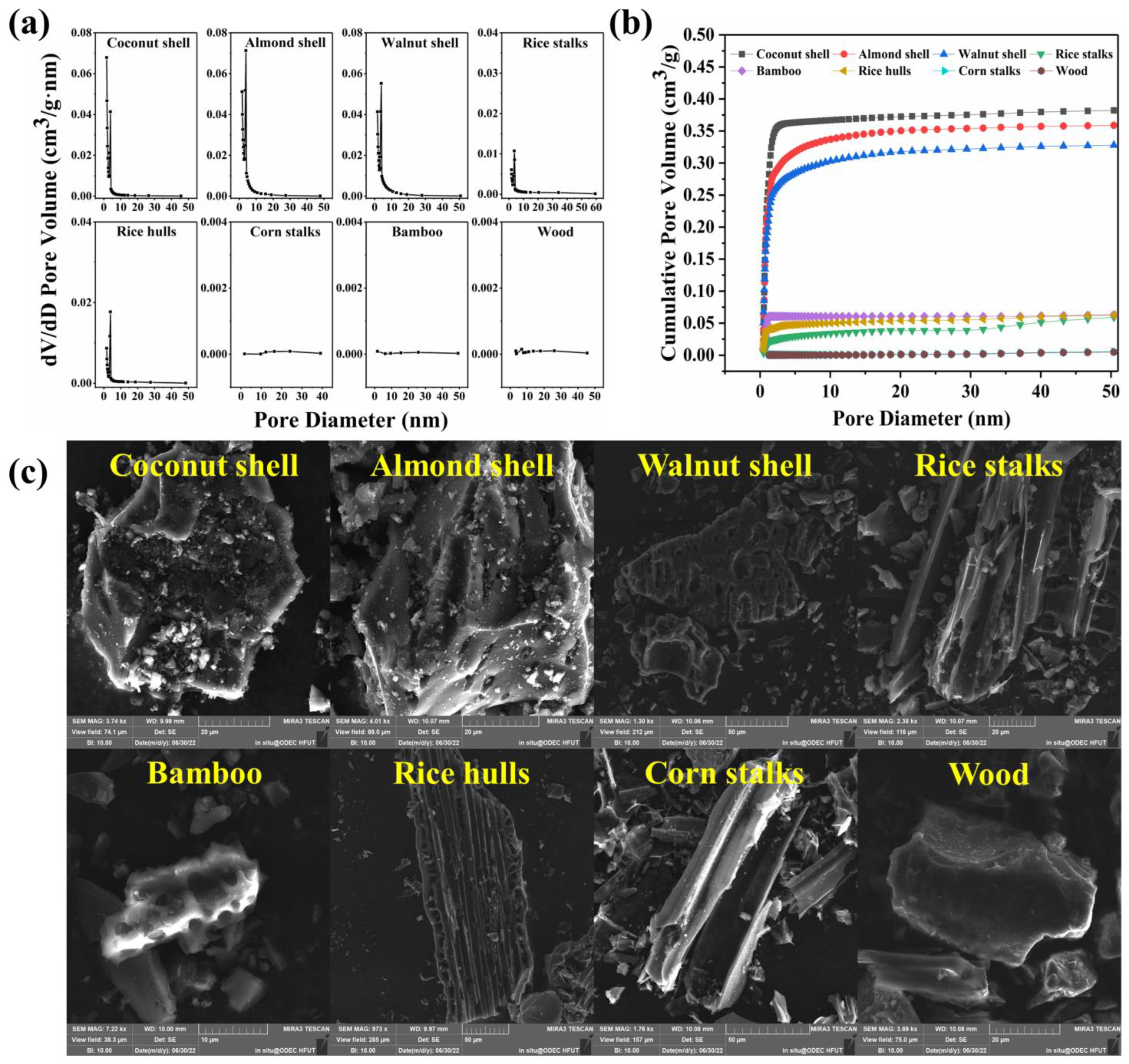
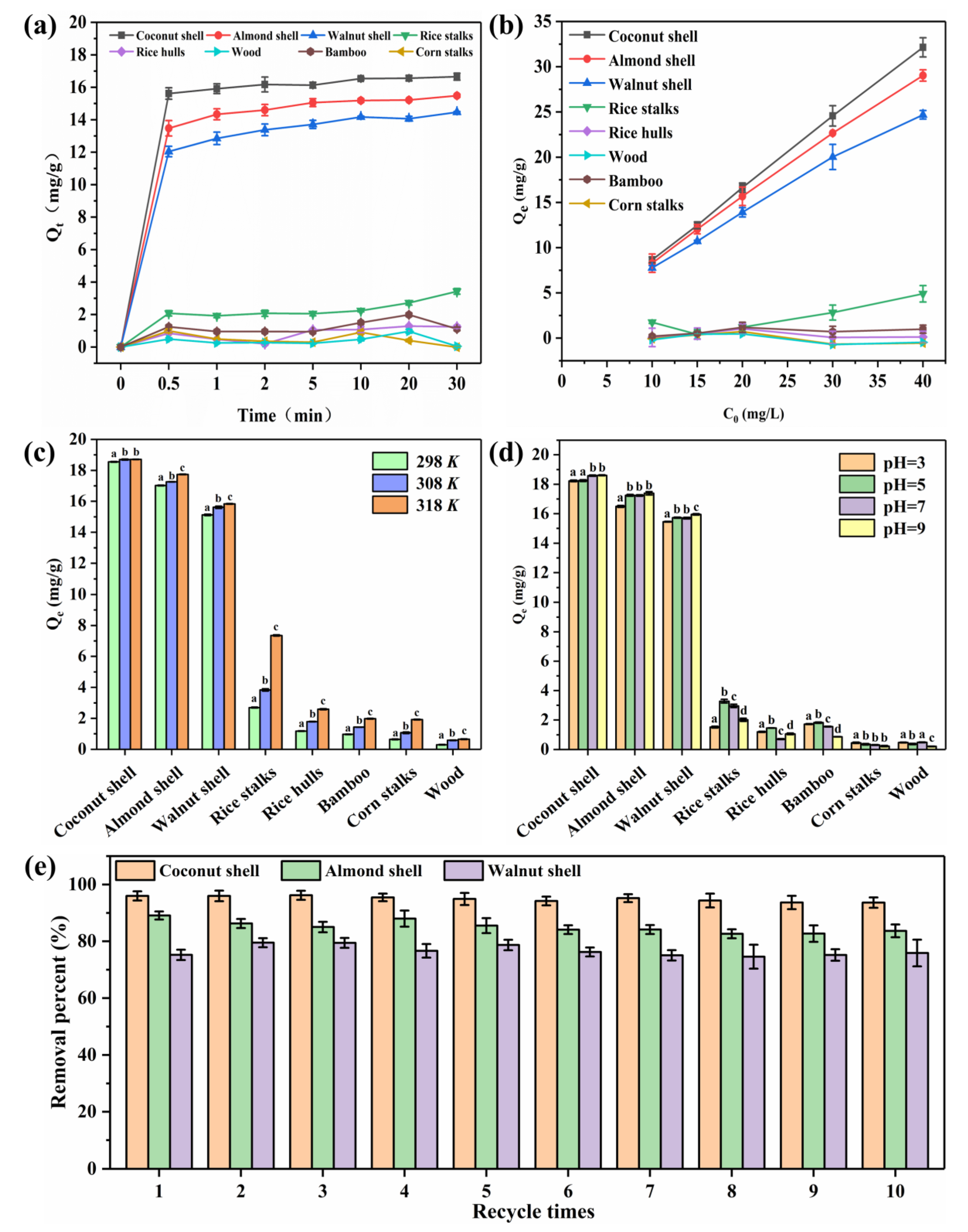
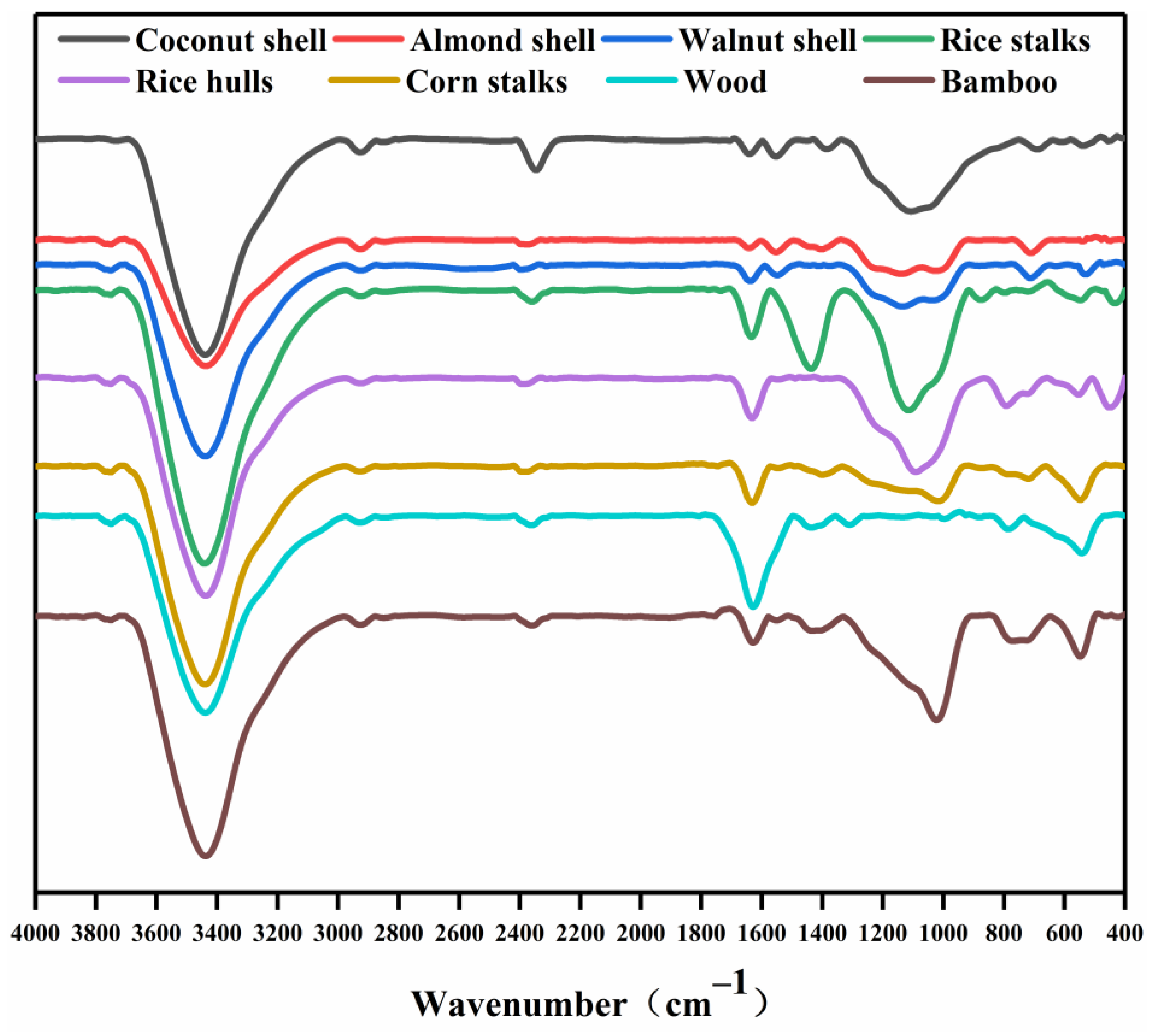
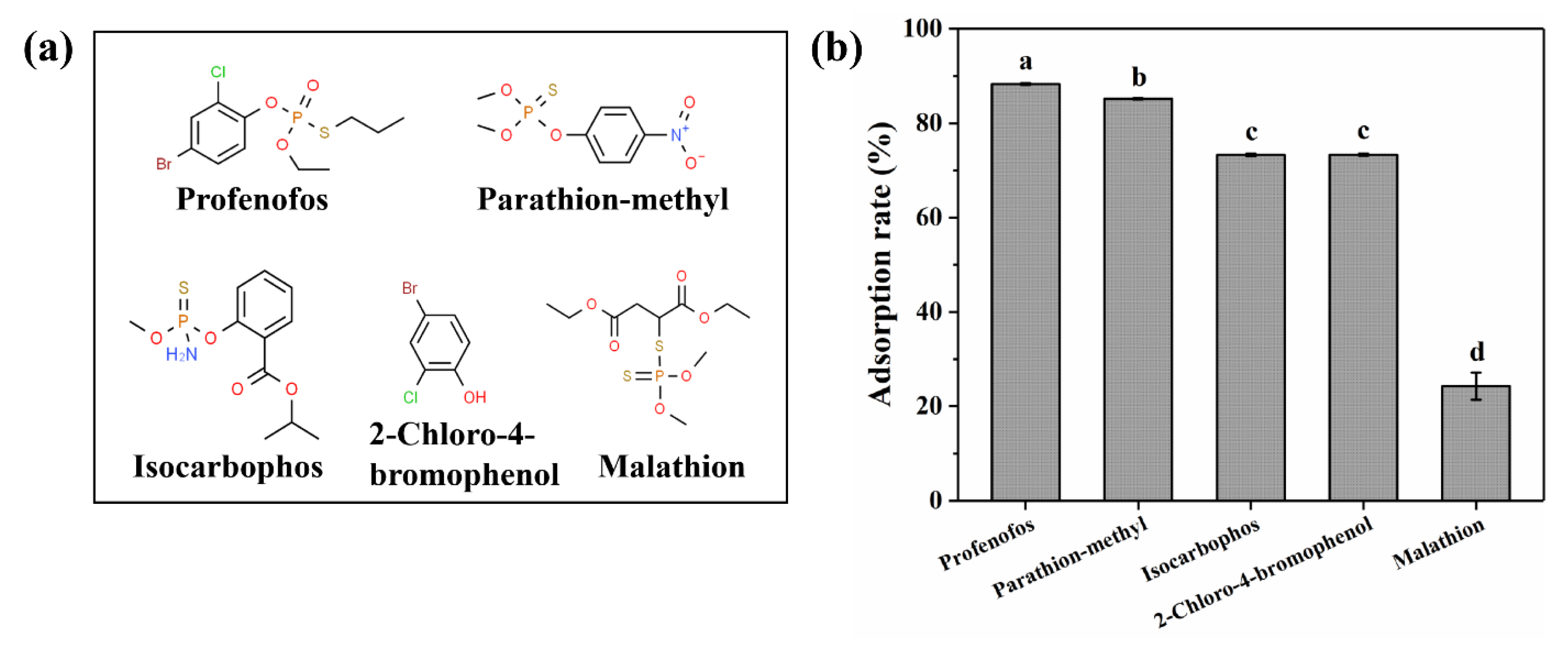
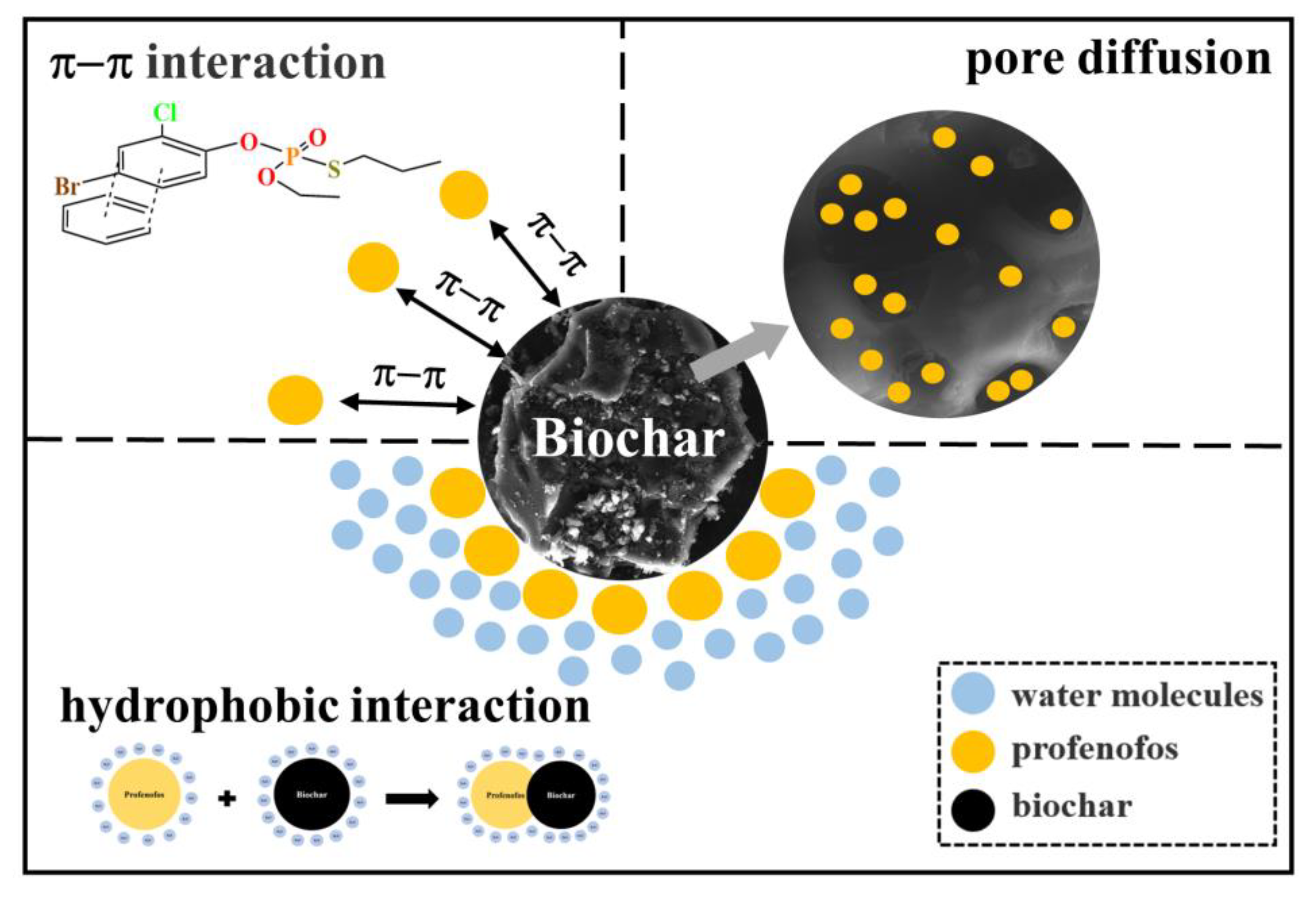
| Biochar | Concentration of Profenofos after Adsorption (mg/L) | Removal (%) |
|---|---|---|
| Blank control | 19.97 ± 0.27 | 0 |
| Coconut shell | 2.34 ± 0.17 | 88 |
| Almond shell | 3.14 ± 0.05 | 84 |
| Walnut shell | 4.97 ± 0.12 | 75 |
| Rice stalks | 16.91 ± 0.14 | 15 |
| Rice hulls | 17.29 ± 0.17 | 13 |
| Bamboo | 18.97 ± 0.15 | 5.0 |
| Corn stalks | 19.23 ± 0.09 | 3.7 |
| Wood | 19.05 ± 0.12 | 4.6 |
| Test Items | Biochar | |||||||
|---|---|---|---|---|---|---|---|---|
| Coconut Shell | Almond Shell | Walnut Shell | Rice Stalks | Bamboo | Rice Hulls | Corn Stalks | Wood | |
| Specific surface area (m2/g) | 817.254 | 710.632 | 640.837 | 72.178 | 144.575 | 113.774 | 3.024 | 1.723 |
| Total pore volume (cm3/g) | 0.454 | 0.434 | 0.397 | 0.052 | 0.073 | 0.071 | 0.003 | 0.002 |
| Micropore volume (cm3/g) | 0.348 | 0.279 | 0.254 | 0.021 | 0.073 | 0.043 | 0.001 | 0.001 |
| Average pore diameter (nm) | 2.224 | 2.442 | 2.478 | 2.893 | 2.027 | 2.481 | 3.888 | 5.379 |
| C% | 85.10 | 78.93 | 83.47 | 30.07 | 65.63 | 33.44 | 52.71 | 47.93 |
| H% | 0.90 | 0.85 | 0.96 | 0.47 | 1.64 | 0.54 | 1.25 | 2.42 |
| N% | 0.20 | 0.26 | 0.34 | 0.59 | 0.57 | 0.42 | 0.94 | 1.28 |
| S% | 0.32 | 0.20 | 0.23 | 1.41 | 0.25 | 0.35 | 0.33 | 0.43 |
| O% | 11.77 | 14.06 | 11.97 | 10.75 | 10.16 | 7.51 | 9.24 | 19.22 |
| Ash% | 1.72 | 5.70 | 3.03 | 56.71 | 21.76 | 57.74 | 35.54 | 28.73 |
| H/C | 0.1262 | 0.1298 | 0.1380 | 0.1884 | 0.2993 | 0.1923 | 0.2839 | 0.6051 |
| O/C | 0.1038 | 0.1336 | 0.1075 | 0.2681 | 0.1161 | 0.1685 | 0.1314 | 0.3007 |
| Model | Biochar | ||||||||
|---|---|---|---|---|---|---|---|---|---|
| Coconut Shell | Almond Shell | Walnut Shell | Rice Stalks | Bamboo | Rice Hulls | Corn Stalks | Wood | ||
| Pseudo first-order model | Qe (mg/g) | 2.08 | 1.32 | 1.69 | 1.54 | - | - | - | - |
| K1 (min−1) | 0.3445 | 0.0680 | 0.0909 | 0.0383 | 0.0034 | 0.1292 | - | 0.0318 | |
| R2 | 0.753 | 0.802 | 0.839 | 0.958 | - | 0.908 | - | - | |
| Pseudo second-order model | Qe (mg/g) | 16.67 | 15.47 | 14.44 | 2.98 | 1.14 | 1.47 | 0.34 | 0.05 |
| K2 (g/mg·min) | 0.7576 | 0.4980 | 0.3653 | 0.2514 | - | 0.1608 | - | - | |
| R2 | 1.000 | 1.000 | 1.000 | 0.987 | 0.989 | 0.855 | 0.935 | 0.582 | |
| Langmuir | Qm (mg/g) | 84.0336 | 56.3698 | 43.1593 | - | 1.2208 | 0.0948 | - | - |
| KL (L/mg) | 0.0764 | 0.0939 | 0.0849 | - | 0.1863 | - | 1.5351 | - | |
| RL | 0.2466 | 0.2103 | 0.2275 | - | 0.2116 | 0.1214 | 0.0315 | 0.4219 | |
| R2 | 0.806 | 0.976 | 0.937 | 0.077 | 0.776 | 0.733 | 0.190 | 0.503 | |
| Freundlich | Kf (L/mg) | 6.6549 | 5.7639 | 4.5715 | 0.1087 | 0.2022 | 0.2420 | - | - |
| 1/n | 0.7592 | 0.6806 | 0.6224 | 0.9322 | 0.6008 | - | - | - | |
| R2 | 0.990 | 1.000 | 0.990 | 0.316 | 0.727 | 0.004 | - | - | |
Disclaimer/Publisher’s Note: The statements, opinions and data contained in all publications are solely those of the individual author(s) and contributor(s) and not of MDPI and/or the editor(s). MDPI and/or the editor(s) disclaim responsibility for any injury to people or property resulting from any ideas, methods, instructions or products referred to in the content. |
© 2023 by the authors. Licensee MDPI, Basel, Switzerland. This article is an open access article distributed under the terms and conditions of the Creative Commons Attribution (CC BY) license (https://creativecommons.org/licenses/by/4.0/).
Share and Cite
Zhang, G.; Fang, L.; Cheng, Z.; Shi, T.; Ma, X.; Li, Q.X.; Hua, R. Highly Efficient Adsorption Characteristics and Mechanism of Nutshell Biochars for Aromatic Organophosphorus Insecticides. Agronomy 2023, 13, 543. https://doi.org/10.3390/agronomy13020543
Zhang G, Fang L, Cheng Z, Shi T, Ma X, Li QX, Hua R. Highly Efficient Adsorption Characteristics and Mechanism of Nutshell Biochars for Aromatic Organophosphorus Insecticides. Agronomy. 2023; 13(2):543. https://doi.org/10.3390/agronomy13020543
Chicago/Turabian StyleZhang, Genrong, Liancheng Fang, Zechao Cheng, Taozhong Shi, Xin Ma, Qing X. Li, and Rimao Hua. 2023. "Highly Efficient Adsorption Characteristics and Mechanism of Nutshell Biochars for Aromatic Organophosphorus Insecticides" Agronomy 13, no. 2: 543. https://doi.org/10.3390/agronomy13020543
APA StyleZhang, G., Fang, L., Cheng, Z., Shi, T., Ma, X., Li, Q. X., & Hua, R. (2023). Highly Efficient Adsorption Characteristics and Mechanism of Nutshell Biochars for Aromatic Organophosphorus Insecticides. Agronomy, 13(2), 543. https://doi.org/10.3390/agronomy13020543








